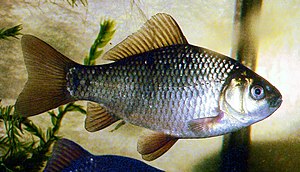Carp-like
| Carp-like | ||||||||||||
|---|---|---|---|---|---|---|---|---|---|---|---|---|

Crucian carp ( Carassius carassius ) |
||||||||||||
| Systematics | ||||||||||||
|
||||||||||||
| Scientific name | ||||||||||||
| Cypriniformes | ||||||||||||
| Goodrich , 1909 |
The carp-like (Cypriniformes) are a species-rich order of freshwater fish . They occur in Europe, Asia, Africa and North America and often dominate the fish fauna there. A third of all freshwater fish and 6% of vertebrate species are carp-like. The biodiversity is greatest in Southeast Asia. Carp-like fish prefer warmer water and are increasingly being replaced by trout fish in the north and in cold mountain streams . They are absent in South America, Madagascar, Australia and east of the Wallace Line . The most well-known types of carp include the carp ( Cyprinus carpio ) and the zebrafish ( Danio rerio ), which has been well researched as a model organism .
features

The carp-like fish are mostly slim to high-backed fish. Among the loach there are also some eel-like elongated shapes ( loach , pangio ). Species from temperate regions and large tropical forms are usually simple, small tropical species are often brightly colored and are popular aquarium fish.
The jaws , the other mouth bones and the gill arches 1 to 4 are toothless, in the pharynx there are one to three rows of pharyngeal teeth on sickle-shaped pharyngeal bones. The fangs are an important feature for species identification. The mouth is often strongly protruding, the lips often covered with barbels . Between processes of the premaxillary there is a bone called kinethmoid, which is typical of the carp-like. The head and gill covers are bare, the trunk covered with elasmoid scales. An adipose fin is missing. Bones , ossifications of the connective tissue between the muscle segments , are often very numerous. The swim bladder is divided into two or three chambers by constrictions and is connected to the foregut, but without an inner wall.
Most carp-like fish are small to medium-sized fish. The largest is Tor putitora , a Southeast Asian cyprinid that can reach a length of 2.75 meters. But also the smallest known fish is carp-like, Paedocypris progenetica reaches a length of 10 mm.
Systematics
The order of the carp-like (Cypriniformes) belongs together with the tetra-like , the catfish-like and two other, species-poor families to the superordinate order of the Ostariophysi , which thus includes the majority of all freshwater fish. The carp-like family belong to 23 families and about 4,300 described species. The number of previously undescribed species is given as around 2500. Many of the families listed today were previously counted as subfamilies of the carp fish (Cyprinidae) and only became independent families in 2016 by Stout and colleagues.

- Subordination gyrinocheiloidei
- Suckling loaches (Gyrinocheilidae) (3 species)
- Subordination to Catostomoidei
- Sucker carp (Catostomidae) (over 70 species)
- Suborder loach- like (Cobitoidei)
- Clown loaches (Botiidae) (over 50 species)
- Vaillantellidae (3 species)
- Wolffish (Cobitidae) (about 195 species)
- Flat loaches (Balitoridae) (over 90 species)
- Fin suckers (Gastromyzontidae) (about 125 species)
- Ellopostomatidae (2 species)
- Brook loaches (Nemacheilidae) (over 400 species)
- Barbuccidae (2 species)
- Serpenticobitidae (3 species)
- Suborder carp fish-like (Cyprinoidei)
- Spindle loaches (Psilorhynchidae) (over 20 species)
- Paedocyprididae (3 species)
- Carp fish (Cyprinidae) (over 1400 species)
- Sundadanionidae ( Sundadanio and Fangfangia , 9 species)
- Bärblinge (Danionidae) (over 300 species)
- Leptobarbidae (5 species)
- Xenocyprididae (about 150 species)
- Tench (Tincidae) (1 species)
- Bitterlings (Acheilognathidae) (about 75 species)
- Gudgeon relatives (Gobionidae) (about 200 species)
- Cardinal fish (Tanichthyidae) (3 species)
- White fish (Leuciscidae) (over 350 species)
The family relationships are illustrated by the following cladogram:
| Cypriniformes |
|
||||||||||||||||||||||||||||||||||||||||||||||||||||||||||||||||||||||||||||||||||||||||||||||||
|
|
literature
- Joseph S. Nelson , Fishes of the World , John Wiley & Sons, 2006, ISBN 0-471-25031-7 .
- Kurt Fiedler, Textbook of Special Zoology, Volume II, Part 2: Fish , Gustav Fischer Verlag Jena, 1991, ISBN 3-334-00339-6 .
- Wilfried Westheide , Reinhard Rieger: Special Zoology. Part 2: vertebrates and skulls. 1st edition, Spektrum Akademischer Verlag, Heidelberg / Berlin 2004, ISBN 3-8274-0307-3 .
Individual evidence
- ↑ a b c d Stout, CC, Tan, M., Lemmon, AR, Moriarty Lemmon, E. & Armbruster, JW (2016): Resolving Cypriniformes relationships using an anchored enrichment approach. BMC Evolutionary Biology, November 2016. DOI: 10.1186 / s12862-016-0819-5
- ↑ Tor putitora on Fishbase.org (English)
- ↑ M. Kottelat, R. Britz, HH Tan & K.-E. Witte. 2005: Paedocypris, a new genus of Southeast Asian cyprinid fish with a remarkable sexual dimorphism, comprises the world's smallest vertebrate. Proceedings of the Royal Society, Volume 273, Number 1589 / April 22, 2006 doi : 10.1098 / rspb.2005.3419
- ↑ Eschmeyer, WN & Fong, JD: Catalog of Fishes Species by Family / Subfamily, accessed on July 13, 2018